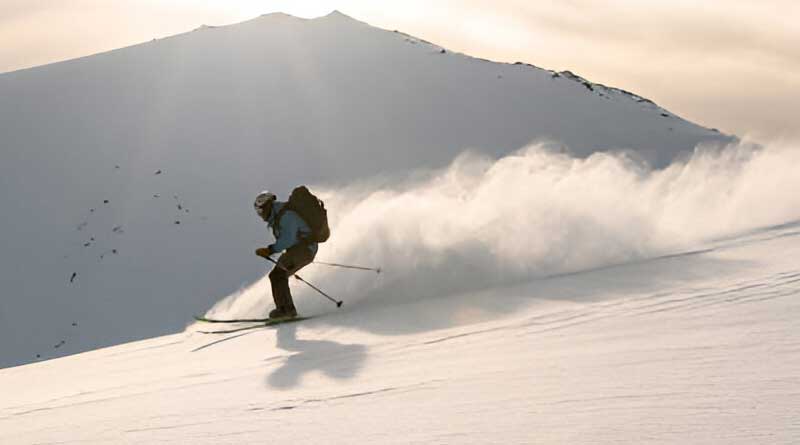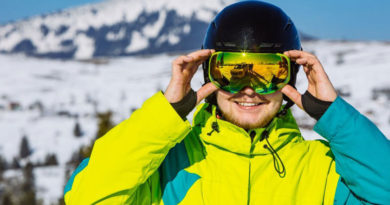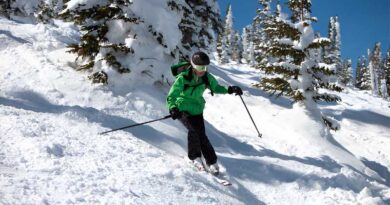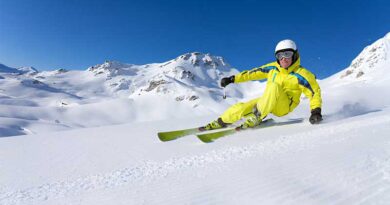Best Skis for Advanced Skiers of 2025
If you’re an advanced skier, you need skis that match your skills. The right pair helps you go faster. It also gives you better control on steep or icy slopes. Advanced skis are built to handle more speed and tougher terrain. They let you push your limits and try new tricks. But not all skis are the same. Some are better for powder, others for carving. Choosing the best one depends on your style. This guide covers the top skis for advanced skiers. We picked models with great reviews and solid performance. Whether you love groomers or backcountry runs, there’s a perfect ski for you here.
1. Atomic Bent 100

-
Core: Light Poplar Woodcore for balanced weight and stability
-
Rocker Type: All-Mountain Rocker (20% tip / 65% camber / 15% tail)
-
Shape: 3D HRZN Bent Tip and Tail for better float and playful performance
-
Sidewalls: Dura Cap Sidewall for solid power transfer and added durability
The Atomic Bent 100 has earned its spot as a modern classic, and the 2024/25 refresh builds on that legacy with thoughtful upgrades. The new 3D HRZN tip and tail design adds even more playfulness to an already versatile ski, giving it extra float and smear-ability in soft snow. The adjusted rocker profile (20/65/15) now leans a little more into freeride territory, which you’ll feel in the looser, surfier turn initiation and better control in variable conditions. The poplar core keeps things light and snappy without sacrificing stability, and it still carves surprisingly well on groomers.
Whether you’re launching side hits, slashing through spring slush, or just cruising groomers with friends, the Bent 100 feels at home. It’s approachable enough for intermediate skiers but comes alive under the feet of advanced riders who like to mix in freestyle or freeride elements. The directional shape provides enough edge grip and control when you need it, while the slightly shorter feel (compared to similar-length skis) makes it nimble in tight spots. The hand-drawn topsheet art is a bonus, adding style to a ski that already brings the fun. Simply put, the Bent 100 continues to be one of the most reliable and enjoyable all-mountain skis available.
Pros:
- Playful and lightweight feel
- Upgraded HRZN tips improve float and maneuverability
- Great on both groomers and off-piste
- Durable sidewalls and edges for long-term use
Cons:
- Skis slightly shorter than listed length
- Not ideal for hard-charging, high-speed carving
1. Nordica Enforcer 94

-
Core: Energy 2 Ti Pulse Core (wood core + elastomer core between two sheets of titanal)
-
Rocker Type: Rocker/Camber/Rocker (All Mountain Rocker)
-
Tail Type: Partial Twin Tip
-
Turning Radius: Medium
The Nordica Enforcer 94 is a top-tier choice for advanced and expert skiers who want power without the punishing feel. Its redesigned core combines wood and an elastomer pulse layer, all sandwiched between two sheets of titanal. This gives it a strong and energetic response while staying smooth underfoot. You get serious edge hold on hardpack, plus the stability to charge through chopped-up snow. At the same time, the ski stays manageable and doesn’t feel overly stiff or demanding, even at higher speeds. Whether you’re carving groomers or tackling crud, the Enforcer 94 delivers a responsive and predictable ride.
What really sets this ski apart is its progressive shaping and partial twin tip. The tail release feels more nimble than you’d expect from a metal-laminated ski. This makes tight turns in trees or variable terrain feel easier and more intuitive. It’s confident but not locked in, which suits advanced skiers who like to explore. The All-Mountain Rocker adds versatility, letting the ski float decently in soft snow while keeping it grippy on firm days. Whether you’re pushing limits or just cruising confidently, the Nordica Enforcer 94 is a balanced, high-performance option.
Pros:
- Strong edge grip and stability
- Smooth and energetic ride
- Versatile across different terrain types
- Nimble tail for improved control in tight spots
Cons:
- Not ideal for deep powder days
- May be too stiff for lighter or less aggressive skiers
See the Nordica Enforcer 94 See the Women’s Santa Ana 92
2. Völkl Mantra 88
-
Core: Multilayer Woodcore (Beech and Poplar)
-
Rocker Type: Tip & Tail Rocker with Camber underfoot
-
Laminates: Tailored Carbon Tips and Tailored Titanal Frame
-
Turning Radius: 3D Radius Sidecut (medium, with variable arc design)
The Völkl Mantra 88 is a powerhouse ski designed for confident skiers who thrive on speed and precision. With a few subtle but meaningful updates, this version of the Mantra 88 offers smoother turn initiation and even greater stability at high speeds. The new Tailored Carbon Tips provide improved handling and performance at the front, making it easier to engage the ski and stay locked in on edge. Meanwhile, the refined Tailored Titanal Frame gives just the right amount of torsional stiffness underfoot for responsive control without making the ski feel too rigid or punishing in the tip.
This ski shines on groomers and hardpack, where it feels fast, planted, and incredibly stable. The 3D Radius Sidecut delivers both long, sweeping turns and tight, technical carving depending on your needs. Combined with the Tip & Tail Rocker, it allows for great versatility while keeping the ski easy to pivot and release when needed. It’s not a playful ski, but that’s not what it’s built for. The Mantra 88 is built for strong intermediate to advanced skiers who want to charge hard and rely on powerful edge hold in a variety of conditions. It rewards aggressive technique and rewards confidence with unmatched control.
Pros:
-
Exceptional edge hold and high-speed stability
-
Smooth turn initiation with versatile turn shapes
-
Strong, durable core with responsive laminates
-
Tailored stiffness for different skier types
Cons:
-
Not ideal for deep powder or soft snow
-
May feel demanding for casual or less heavier skiers
See the Völkl Mantra 88 See the Women’s Mantra 88 W
3. Elan Ripstick 96

-
Core: TubeLite Wood Core with integrated Carbon Rods
-
Rocker Type: Amphibio Profile (Asymmetrical Rocker/Camber Design)
-
Laminates: UD Carbon, Flax Fiber, and Carbon Deck Technology
-
Tail Type: Flat
The Elan Ripstick 96 is a lightweight yet powerful all-mountain ski that blends agility with stability. The standout Amphibio Profile delivers a unique experience with its asymmetrical design—each ski has a distinct inside and outside edge. This results in exceptional edge hold and easy turn initiation, especially on hardpack. The TubeLite Wood Core, with carbon tubes running the length of the ski, provides solid torsional stability and snappy rebound without adding weight. Flax fiber and UD carbon upgrades give the ski a smoother, quieter ride on choppy snow, enhancing confidence in variable conditions. This makes the Ripstick 96 a great daily driver for intermediate to advanced skiers.
What really sets the Ripstick 96 apart is its ability to adapt. It’s quick edge-to-edge, stable at speed, and light enough for sidecountry missions. The flat tail and short turning radius make it responsive in tight spots, while the rockered outside edge helps it float decently in fresh snow. Whether you’re carving groomers, exploring off-piste, or zipping through trees, the ski maintains a lively yet predictable feel. Thanks to the Slanted Sidewall Technology, power transfer is direct and efficient. Overall, the Ripstick 96 strikes an excellent balance of performance, versatility, and forgiveness.
Pros:
- Asymmetrical Amphibio profile boosts edge grip and turn ease
- Lightweight yet stable with excellent rebound
- Smooth ride on hard, chattery snow
- Great all-mountain versatility
Cons:
- May lack power for very aggressive skiers
- Asymmetrical design takes some adjustment
See the Elan Ripstick 96 See the Women’s Ripstick 94
4. Salomon QST 106

-
Core: Full Poplar Woodcore
-
Rocker Type: Freeride Rocker (25% Tip Rocker / Camber / 17% Tail Rocker)
-
Laminates: Basalt & Fiberglass with Cork Damplifier inserts
-
Tail Type: Partial Twin Tip
The Salomon QST 106 continues its reign as a go-to ski for all-mountain and big mountain enthusiasts. Built around a full poplar wood core, it offers solid power and stability from tip to tail. The updated basalt and fiberglass layup adds flex control and edge grip, while the Cork Damplifier inserts in the tips and tails significantly reduce chatter. These thoughtful updates give the ski a smoother, more controlled feel on everything from soft powder to chopped-up afternoon snow. With its freeride rocker profile, the QST 106 floats well in deep snow yet maintains enough camber underfoot to stay nimble and responsive on harder terrain.
This ski truly excels in off-piste conditions, especially for those who spend time beyond the groomers. The 106mm waist offers ample surface area for floatation without being too sluggish in tighter terrain. It turns easily thanks to the revised shape and moderate taper, making it a joy to maneuver through trees or steep bowls. While it’s happiest in soft snow and variable conditions, it holds its own on firmer runs as well. The QST 106 blends power, playfulness, and stability in a way that’s ideal for intermediate to advanced skiers who want one ski that can do it all.
Pros:
- Excellent float in powder and soft snow
- Smooth, damp ride thanks to cork inserts
- Strong edge hold with good flex control
- Versatile for all-mountain and big mountain use
Cons:
- Not as precise on firm, icy groomers
- Might feel wide for tighter, technical terrain
See the Salomon QST 106 See the Women’s QST Stella 106
5. Völkl M7 Mantra

-
Core: Multilayer Woodcore (Beech and Poplar)
-
Rocker Type: Tip & Tail Rocker with camber underfoot
-
Shape: 4 Radius Drive (20m, 40m, 15m, 25m radii for varied turn response)
-
Laminates: Tailored Carbon Tips and Tailored Titanal Frame
The Völkl M7 Mantra builds on the success of the M6 with smart refinements that elevate performance without sacrificing power. The standout 4 Radius Drive sidecut allows for smooth transitions between fast, long arcs and tight, snappy turns. Combined with a multilayer wood core and precisely tuned Titanal frame, the M7 thrives at high speeds and rewards strong, technical skiers who like to push limits. It still feels stout and damp underfoot, but the updated shape adds versatility, allowing the ski to feel more maneuverable without compromising stability.
While the M7 is slightly lighter than its predecessor, it hasn’t gone soft. The tailored carbon tips and full-length sidewalls deliver incredible edge grip and quick engagement, especially on groomers and firm snow. This is a ski built for experienced riders who want precision and power, not forgiveness. That said, the improved agility means it’s now more approachable in varied terrain and conditions, especially for those who don’t want to be on full edge every second. For aggressive skiers looking for a high-speed, all-mountain tool that carves with confidence and charges through crud, the M7 Mantra remains a top contender.
Pros:
-
Excellent stability at high speed
-
Versatile sidecut handles short and long turns well
-
Tailored construction boosts precision and control
-
Great edge hold on firm snow
Cons:
-
Demands good technique and strength
-
Less forgiving for casual or beginner skiers
See the Völkl M7 Mantra See the Women’s Secret 88
7. Black Crows Justis

-
Core: Poplar with Fiberglass for strength and responsiveness
-
Laminates: Double Titanal H-Shape Plates for maximum edge grip and energy transfer
-
Rocker Type: Progressive Front Rocker / Light Rear Rocker with Classic Camber
-
Sidewalls: Semi-Cap with ABS Sidewalls for durability and control
The Black Crows Justis is built for aggressive resort skiers who want powerful performance across the mountain without giving up agility. With a 100mm waist and dual Titanal H-shaped plates, the ski holds a confident edge even at high speeds and plows through variable snow like a tank. The combination of a progressive front rocker and light tail rocker gives it a responsive feel, allowing quick pivots when needed while maintaining strong drive in long arcs. The Justis feels solid underfoot and rewards skiers who know how to put their weight into a carve.
Despite its stiff flex and metal laminate construction, the Justis isn’t overly demanding. The poplar and fiberglass core helps keep the weight manageable and makes it surprisingly nimble for a ski in this category. Whether you’re railing groomers, busting through crud, or dipping into some fresh off the side, the Justis thrives. It’s not the most playful or forgiving ski out there, but for advanced to expert riders looking for a dependable, energetic, and stable all-mountain tool, it hits the mark. Think of it as a ski that leans toward charger, but still has enough finesse to adapt when the terrain gets tight or tricky.
Pros:
- Extremely stable and powerful at speed
- Handles variable snow with ease
- Responsive edge-to-edge transitions
- Great mix of carving ability and freeride feel
Cons:
- Not ideal for lighter or less aggressive skiers
- Lacks the playfulness of softer-flex skis
How to Choose Skis for Advanced Skiers?
For advanced skiers, choosing the right skis is a matter of fine-tuning performance, not just getting down the hill. You’ve already built a solid foundation of skills, can handle steeper terrain, and likely enjoy exploring different snow conditions. Now, the right pair of skis can help unlock your full potential—whether you’re carving high-speed turns, charging through powder, or navigating chopped-up afternoon crud.
With the vast variety of ski types, constructions, and technologies available today, selecting the perfect ski can feel overwhelming. Here’s a complete guide to help you make the best choice.
1. Define Your Skiing Style and Terrain Preferences
Before diving into specs, it’s important to understand how and where you like to ski.
-
All-Mountain Skier: You ski groomers, venture off-piste, and need one ski to do it all.
-
Freerider: You live for powder days, cliff drops, and off-piste adventures.
-
Frontside Carver: You love the feel of aggressive carving on groomed slopes.
-
Freestyle Skier: You prefer spins, jibs, and park laps.
-
Ski Tourer: You climb for your turns and need lightweight, versatile skis.
Your preferred terrain heavily influences ski width, stiffness, and rocker profile.
2. Waist Width: Tailor to Terrain
Waist width—the width of the ski underfoot—plays a huge role in performance.
-
80–90mm: Best for groomed runs and high-speed carving.
-
90–100mm: Ideal for mixed conditions—good float in powder while retaining on-piste control.
-
100–110mm: Suited for deep snow and off-piste terrain.
-
110mm+: For pure powder hounds who spend almost no time on groomers.
Advanced skiers often opt for a mid-fat ski (95–105mm) for versatility, especially in variable snow.
3. Flex: Responsive vs. Forgiving
Ski flex determines how the ski behaves under pressure.
-
Stiff Flex: Offers better edge grip, stability, and high-speed performance. Ideal for aggressive skiers who ski fast and hard.
-
Medium Flex: Balances responsiveness and forgiveness. Great for varied terrain.
-
Soft Flex: Easier to turn but lacks stability at speed—usually not preferred by advanced skiers.
Look for skis with tailored flex patterns—stiffer underfoot for power, with softer tips for easier turn initiation.
4. Rocker, Camber, and Profile Combinations
The ski profile affects how the ski contacts the snow.
-
Camber: The ski arches up in the middle. Great edge grip and pop for carving.
-
Rocker (Tip and Tail): The ski tips rise early, improving float in powder and ease of turn initiation.
-
Rocker/Camber/Rocker: Most versatile, combining edge hold with forgiveness.
-
Full Rocker: Excellent for powder but can feel loose on hardpack.
For advanced riders, a rocker/camber/rocker or camber-heavy profile usually provides the best balance of control and fun.
5. Sidecut Radius: Turn Style and Control
Sidecut radius refers to the curve along the ski’s edge and determines the shape of your turns.
-
<15 meters: Quick, snappy turns. Great for moguls and tight trees.
-
15–20 meters: Versatile, medium-radius turns.
-
20+ meters: Long, sweeping turns and high-speed stability.
Choose the radius based on your turn style—skiers who like arcing GS-style turns at speed should look for a longer radius, while those who prefer tighter turns may opt for something shorter.
6. Construction: Material Matters
Advanced skis often feature high-end materials and construction techniques for enhanced performance.
-
Titanal (Metal Layers): Adds dampening and torsional stiffness. Great for aggressive skiers.
-
Carbon: Lightweight and responsive. Offers energy and pop without excess weight.
-
Wood Core: Most performance skis use wood (poplar, beech, ash). Durable and responsive.
-
Sidewalls: Full or semi-cap sidewalls improve edge grip and power transmission.
If you like to ski hard and fast, look for skis with titanal or carbon layers and a full sidewall construction.
7. Length: Size for Stability and Style
Longer skis offer better float and speed stability, while shorter skis are easier to maneuver.
You should prefer skis that are:
-
Around head height to 10cm longer for all-mountain or freeride use.
-
Slightly shorter for freestyle or tight, technical terrain.
Also consider rocker and taper—rockered tips and tails can make longer skis feel more nimble.
8. Consider Mounting Point and Bindings
Bindings can affect feel and control:
-
Traditional Mount: Better for directional skiing, carves, and big-mountain lines.
-
Centered Mount: More playful, great for switch skiing and park use.
-
Shiftable Bindings: Allow minor tweaks in stance to suit different conditions.
Choose a binding with a DIN setting that matches your weight and ability—higher DIN ranges offer more retention for aggressive skiing.
9. Test Before You Buy (If Possible)
Even with all the specs lined up, nothing beats skiing a ski before you buy. Many resorts and shops offer demo programs—test a few pairs back-to-back to feel subtle differences in stiffness, turn radius, and overall performance.
If demoing isn’t possible, check detailed reviews or video comparisons from skiers with a similar style and body type to yours.
10. Examples of Great Skis
Here are a few tried-and-tested models that skiers often love:
-
Völkl Mantra M7: A powerful all-mountain charger with Titanal and precise edge hold.
-
Salomon QST 106: Versatile and damp, great for powder and mixed terrain.
-
Atomic Bent 100: Playful and well-balanced for freeride and freestyle crossover.
-
Blizzard Bonafide 97: Stiff, stable, and ready for hard-charging groomers and off-piste.
-
Black Crows Justis: A strong all-mountain ski with serious edge power and float.
Final Thoughts
Advanced skiers have earned the right to be picky—and with so many excellent skis on the market, there’s no reason to settle for something that doesn’t match your style. Focus on your terrain preference, skiing style, and how you want the ski to feel underfoot. Whether you’re carving on corduroy, launching off wind lips, or just chasing pow, the right ski is out there waiting to elevate your experience.
Take your time, read reviews, and if you can—demo before you commit. Your perfect ski is out there. When you find it, you’ll know.




